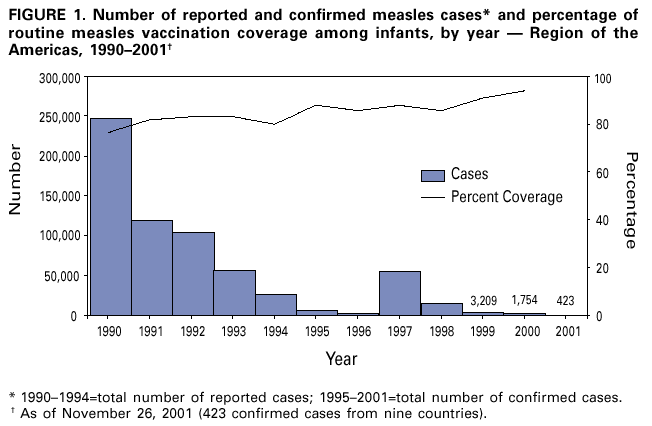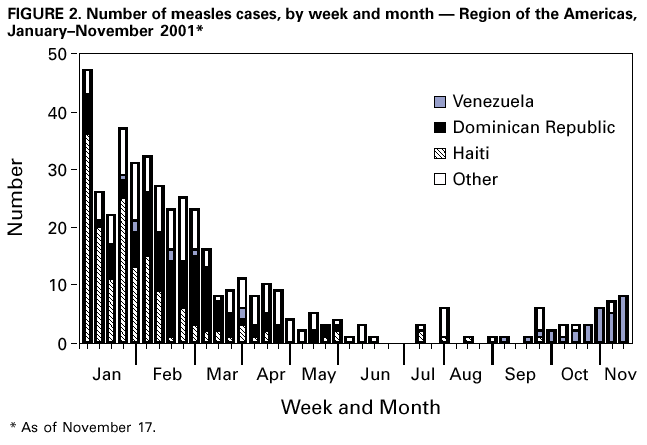 |
|
|
|
|
|
|
| ||||||||||
|
|
|
|
|
|
|
||||
| ||||||||||
|
|
|
|
|
Persons using assistive technology might not be able to fully access information in this file. For assistance, please send e-mail to: mmwrq@cdc.gov. Type 508 Accommodation and the title of the report in the subject line of e-mail. Progress Toward Interrupting Indigenous Measles Transmission ---Region of the Americas, January--November 2001In 1994, countries in the Region of the Americas set a goal of interrupting indigenous measles transmission by the end of 2000 (1). During 1990--2000, measles cases declined 99.3%, from approximately 250,000 to 1,754 (Figure 1). During 2000, transmission occurred in five of 41 countries that report to the Pan American Health Organization (PAHO) (Argentina, Bolivia, Brazil, the Dominican Republic, and Haiti), and confirmed cases were reported in 16 (<1%) of 12,010 municipalities (2--4). During 2001, measles transmission occurred in the Dominican Republic, Haiti, and Venezuela; no outbreaks were reported in Argentina, Bolivia, or Brazil. This report summarizes measles circulation patterns and efforts to interrupt measles transmission in the Americas during 2001. The measles vaccination strategy recommended by PAHO includes a one-time national "catch-up" campaign for all children aged 1--14 years, routine "keep-up" vaccination for infants aged 1 year, and national "follow-up" campaigns every 3--5 years for all children aged 1--4 years, regardless of measles vaccination history (5). Thirty-nine (95%) of the 41 countries that report to PAHO conducted catch-up campaigns during 1989--1995 and follow-up campaigns since 1994. Routine coverage increased from 80% in 1994 to 94% in 2000 but varied by country from 75% to 99%; coverage was lowest in Colombia (75%), Haiti (80%), Belize (82%), Venezuela and Costa Rica (84%), Guyana (86%), Jamaica (88%), and the Dominican Republic (88%). Vaccination efforts also have been focused on populations at high risk for measles transmission (e.g., health-care workers, military personnel, teachers, university students, workers in the tourist industry, persons living or working in prisons and large factories, and young adults from rural areas who have moved to cities) in Argentina, Bolivia, Chile, the Dominican Republic, Haiti, Peru, Uruguay, and Venezuela (6). During January--mid-November 2001, a total of 423 confirmed measles cases were reported in the Americas, the lowest number of cases for the first 46 weeks of any year since implementation of the eradication program in 1996 and a 65% decrease compared with the 1,202 cases reported during the same period in 2000 (Figure 2). The number of cases reported annually has decreased substantially since the resurgence that occurred in Argentina and Brazil during 1997 (7). In 1998, a total of 14,332 confirmed cases were reported from 17 (41%) of the 41 PAHO-reporting countries. In 1999, a total of 3,209 confirmed cases were reported from 11 countries, 78% fewer cases than in 1998 and 94% fewer than in 1997 (7,8). The 1,754 cases reported during 2000 was the lowest number since the goal to interrupt measles transmission was set in 1994 (Figure 1) (7). During 1999--2000, a total of 528 confirmed measles cases were reported in the Dominican Republic. During January--mid-November 2001, a total of 113 (27%) of the 423 confirmed cases in the region were reported from 18 provinces. The highest attack rates occurred among children aged <5 years (range: from two cases per 100,000 children aged 1--4 years to 18 cases per 100,000 children aged 6--11 months), children aged 5--9 years (one case per 100,000), and adults aged 20--29 years (two cases per 100,000). As of November 17, 2001, a total of 1,097 suspected cases of measles have been investigated; the last patient with a confirmed case of illness had symptom onset during May 2001. In Haiti, no confirmed cases were reported during 1998--1999. In 2000, an outbreak probably caused by measles imported from the Dominican Republic began in Artibonite; 992 (57%) of 1,754 confirmed cases in the region were reported. From January 2000 to April 2001, fixed-post vaccination campaigns for all vaccines were conducted nationwide; coverage ranged from 45% to 65%. A house-to-house vaccination campaign was conducted in the most affected neighborhood of the country, Delmas, Port au Prince, interrupting transmission in that municipality. During January 1--mid-November 2001, Haiti reported 158 (37%) of the 423 confirmed cases in the region; 49% of the cases occurred among children aged <5 years. A nationwide house-to-house poliomyelitis and measles vaccination campaign began in September 2001. Active case finding is under way, including house-to-house surveillance in all municipalities and a $100 reward for identifying laboratory-confirmed cases. No confirmed measles cases have been reported since the end of September 2001 (9). In Venezuela during 2000, an outbreak of 22 confirmed cases among preschool and school-aged children occurred in Zulia, the most populous state, which borders Colombia. During January--June 2001, eight cases were classified as clinically confirmed, and during August--mid-November, 30 confirmed cases linked to an importation from Europe were confirmed (Figure 2). Of these 30 cases, 19 occurred in two municipalities in Falcon and 11 occurred in two municipalities in Zulia. Seventeen (57%) occurred among children aged <5 years, 12 (40%) among persons aged 22--45 years, and one among a child aged 8 years. Among children aged <5 years, two (12%) had received measles vaccine. Following the recommendations of a PAHO-sponsored evaluation of Venezuela's National Immunization Program, the government is implementing a nationwide, house- to-house, follow-up measles and rubella vaccination campaign among children aged 1--4 years. The campaign started in November 2001 and will end in January 2002. In the campaign's first week, 878,000 children (39% of the target population of approximately 2.3 million) were vaccinated. Reported by: H Izurieta, M Brana, V Dietz, L Venczel, P Carrasco, G Tambini, C Castillo-Solorzano, M Landaverde, CA de Quadros, Div of Vaccines and Immunizations, Pan American Health Organization, Washington, DC. C Pedreira, Pan American Health Organization, Santo Domingo; Z Garib, Ministry of Health, Dominican Republic. O Barrezueta, Pan American Health Organization; R Russo, G García, Ministry of Health, Caracas, Venezuela. F Laender, J Dobbins, J André, Pan American Health Organization; P Delormo, Ministry of Health, Port au Prince, Haiti. Caribbean Epidemiology Center, Trinidad and Tobago. Respiratory and Enteric Viruses Br, Div of Viral and Rickettsial Diseases, National Center for Infectious Diseases; Global Measles Br, Global Immunization Div, National Immunization Program, CDC. Editorial Note:The World Health Organization (WHO) has estimated that 777,000 children died as a result of measles during 2000. During 1997--1998, approximately 100 measles-related deaths were reported in Argentina and Brazil, most among unvaccinated infants and preschool-aged children. Vaccinating poor children against measles substantially improves their long-term chances for survival (10). During 1990--2000, implementation of national vaccination and surveillance programs reduced measles incidence by 99% (5). Haiti and Venezuela are the last countries in the Americas where measles is endemic. Surveillance data and results of molecular testing by PAHO's measles laboratory network demonstrate that measles can be imported to measles-free countries from countries where measles is endemic; therefore, all countries in the region must continue to implement vaccination and surveillance strategies. All countries in the Americas must maintain the highest possible population immunity (i.e., >95% among infants and children) and must strengthen surveillance to detect importations. In addition, countries must target vaccination efforts to susceptible adolescents and young adults who are at risk for exposure to measles. In all countries of the Americas, the elimination of measles will require improving technical and managerial capabilities such as maintaining the cold chain and the local capacity to plan and conduct vaccination campaigns on a regular basis (once every 3--5 years). In countries that report adequate routine coverage, local data need to be verified to identify areas where coverage persists at low levels. Even so, ongoing transmission of measles probably would be detected in the Americas as a result of intense surveillance and active case finding at health-care centers in high-risk communities. PAHO is implementing standard supervisory instruments for monitoring vaccination coverage, investigating measles outbreaks, and validating routine surveillance. In addition, experience in the Americas has demonstrated that house-to-house vaccination is the most efficient method of vaccinating persons living in high-risk and hard-to-reach areas. During measles outbreaks in Haiti and Bolivia, door-to-door vaccination was essential in reaching target coverage levels. The importations of measles virus in the Americas during 2001 underscore the importance of controlling measles in other regions of the world; therefore, PAHO has encouraged other WHO regions to accelerate their measles control programs. In March 2001, WHO and United Nations Children's Fund (UNICEF) announced a joint initiative to decrease by 50% the number of global measles deaths by 2005. This is an important step toward a concerted effort to accelerate global measles control. References
Figure 1  Return to top. Figure 2  Return to top.
Disclaimer All MMWR HTML versions of articles are electronic conversions from ASCII text into HTML. This conversion may have resulted in character translation or format errors in the HTML version. Users should not rely on this HTML document, but are referred to the electronic PDF version and/or the original MMWR paper copy for the official text, figures, and tables. An original paper copy of this issue can be obtained from the Superintendent of Documents, U.S. Government Printing Office (GPO), Washington, DC 20402-9371; telephone: (202) 512-1800. Contact GPO for current prices. **Questions or messages regarding errors in formatting should be addressed to mmwrq@cdc.gov.Page converted: 12/20/2001 |
|||||||||
This page last reviewed 12/20/2001
|